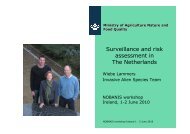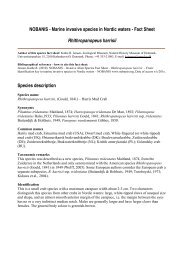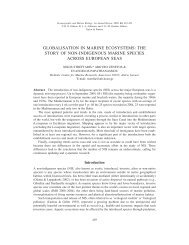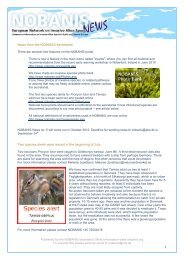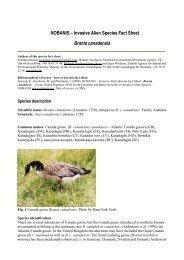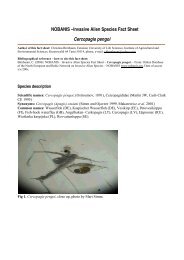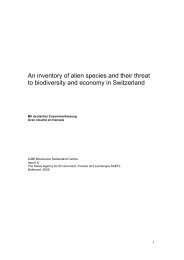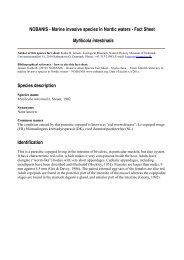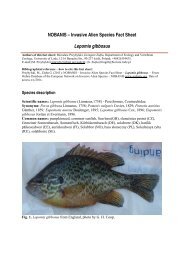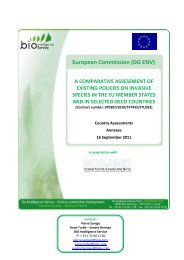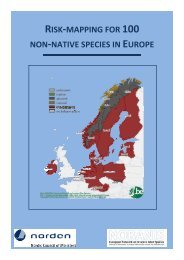Phytophthora ramorum - NOBANIS
Phytophthora ramorum - NOBANIS
Phytophthora ramorum - NOBANIS
You also want an ePaper? Increase the reach of your titles
YUMPU automatically turns print PDFs into web optimized ePapers that Google loves.
<strong>NOBANIS</strong> –Invasive Alien Species Fact Sheet<br />
<strong>Phytophthora</strong> <strong>ramorum</strong><br />
Author of this species fact sheet: Arja Lilja, Finnish Forest Research Institute, Vantaa Research Unit, PO Box 18, 01301<br />
Vantaa, Finland; +358 10 211 2457; arja.lilja@metla.fi<br />
Bibliographical reference – how to cite this fact sheet:<br />
Lilja, A: <strong>NOBANIS</strong> – Invasive Alien Species Fact Sheet – <strong>Phytophthora</strong> <strong>ramorum</strong>. – From: Online Database of the North<br />
European and Baltic Network on Invasive Alien Species – <strong>NOBANIS</strong> www.nobanis.org, Date of access x/x/200x.<br />
Species description<br />
Scientific names: <strong>Phytophthora</strong> <strong>ramorum</strong> Werres, De Cock & Man in`t Veld, Oomycetes, Chromista.<br />
Synonyms: None.<br />
Common names: Twig and leaf blight (EU), Ramorum leaf blight (North America), Sudden Oak<br />
Death= SOD (North America), maladie de l’encre des chênes rouges (FR), mort subite du chêne (FR),<br />
tammen äkkikuolema (FI), europæisk visneskimmel (DK, European isolate) / californisk visneskimmel<br />
(DK, North American isolate), Plötslig ekdöd (SE).<br />
Fig 1. Sporangia of <strong>Phytophthora</strong> <strong>ramorum</strong> in soil extract water, photo by Arja Lilja.
Fig 2. Branched dendroid like hyphae of <strong>Phytophthora</strong> <strong>ramorum</strong> on bottom of agar plate, photo by<br />
Arja Lilja.<br />
Fig 3. Clamydospore of <strong>Phytophthora</strong> <strong>ramorum</strong>, photo by Arja Lilja.<br />
Species identification<br />
<strong>Phytophthora</strong> <strong>ramorum</strong> is a heterothallic species characterized by abundant production of<br />
chlamydospores and elongate, ellipsoid, deciduous sporangia. The mean sporangium length was 43.6<br />
μm ± 5.3 with a range from 20-79 μm and the mean sporangium width was 23.9 μm ± 2.6 with a range<br />
from 12-40 μm in measurements done by Werres and Kaminski (2005). Oogonia with amphigynous<br />
antheridia were produced by parings with P. cryptogea and other heterothallic <strong>Phytophthora</strong> species<br />
representing opposite mating type A2 or A1 (Werres et al. 2001, Werres and Kaminski 2005).<br />
In general different mating types occurred in Europe (A1) and in North America (A2). However, in<br />
2003 the occurrence of a few isolates of P. <strong>ramorum</strong> belonging to A1 type was reported from<br />
horticultural nurseries in North America and A2 type from Europe (Hansen et al. 2003, Werres and De<br />
Merlier 2003).<br />
The EU phytosanitary legistation (Comission Decision 2002/757/EC) concerning plant import<br />
distinguish between European and non-European isolates of P. <strong>ramorum</strong>.<br />
Native range<br />
<strong>Phytophthora</strong> <strong>ramorum</strong> has been separately introduced into North America and into Europe from a<br />
third area which remains unknown (Brasier 2003, Ivors et al. 2004, Rizzo et al. 2005).
Alien distribution<br />
History of introduction and geographical spread<br />
In 2001 a <strong>Phytophthora</strong> associated with a twig blight disease on Rhododendron and Viburnum in<br />
Germany and Netherlands was described as a new species, P. <strong>ramorum</strong> (Werres et al. 2001). Later it<br />
was found to be responsible for the Sudden Oak Death disease (SOD) of Quercus and Lithocarpus spp.<br />
in California, USA (Rizzo et al. 2002). The spread of P. <strong>ramorum</strong> in North America has been very<br />
rapid. The disease was first discovered on Lithocarpus spp. near Mill Valley in 1995. Since then it has<br />
spread throughout coastal counties around the San Franscisco Bay area where many L. densiflorus, Q.<br />
agrifolia, and Q. kelloggii have been killed (Rizzo et al. 2002, Davidson et al. 2002, 2005). It has now<br />
spread to Washington and Oregon and has once been reported in a nursery in British Columbia, Canada<br />
(Hansen et al. 2003, Davidson et al. 2005).<br />
P. <strong>ramorum</strong> has been found mainly in nurseries and garden centres, in many European countries, e.g. in<br />
Belgium, Denmark, Finland, France, Germany, Ireland, Italy, Norway, Poland, Slovenia, Spain,<br />
Sweden and Switzerland (Werres et al. 2001, Delatour et al. 2002, Moralejo and Werres 2002,<br />
Orlikowski and Szkuta 2002, De Merlier et al. 2003, Heiniger et al. 2004, Orlikowski et al. 2004,<br />
Pintos et al. 2004, Zerjav et al. 2004, Orlikowski 2005, Swedish Board of Agriculture 2005). In the UK<br />
and the Netherlands P. <strong>ramorum</strong> has also been found on mature trees (Brasier et al. 2004, Anonymous<br />
2004a, Anonymous 2004b).<br />
Pathways of introduction<br />
It is not known how P. <strong>ramorum</strong> originally entered Europe or North America, but the mating type and<br />
population distribution suggests that separate introductions into Europe and into North America may<br />
have occurred from a third unknown location (Ivors et al. 2004). It is, however, probable that imported,<br />
infected ornamentals have been the main source of the pathogen.<br />
Alien status in region<br />
In Europe, P. <strong>ramorum</strong> was first found on Rhododendron and Viburnum, but later it was isolated on a<br />
variety of plant genera and species, e.g. Arbutus, Calluna vulgaris, Camellia, Hamamelis, Kalmia,<br />
Laurus, Leucothoe, Parrotia, Photinia fraseri, Pieris, Syringa and Vaccinium vitis-idaea (Orlikowski<br />
and Szkuta 2002, Werres and De Merlier 2003, Beales et al. 2004a, Beales et al. 2004b). In 2003, the<br />
pathogen was found on Quercus falcata in the UK, and shortly afterward on Fagus sylvatica, Fraxinus<br />
excelsior, Quercus ilex, Q. cerris, Castanea sativa, Taxus baccata, Nothofagus and Aesculus<br />
hippocastanum (Brasier et al. 2004, Lane et al. 2004, Anonymous 2004a, Orlikowski et al. 2004,<br />
Orlikowski 2005). In the Netherlands the microbe has been isolated from Q. rubra near diseased<br />
Rhododendrons (Anonymous 2004b).<br />
In North America tree hosts are besides L. densiflorus, Q. agrifolia, Q. kellogii and Q. parvula var.<br />
shrevei species such as Q. chrysolepis, Umbellularia californica, Sequoia sempervirens, Pseudostuga<br />
menziesii, Abies grandis, Acer macrophyllum and Aesculus californica. The pathogen has also been<br />
found on Arbutus menziesii, Arctostaphylos manzanita, Camellia spp., Corylus cornuta, Heteromeles<br />
arbutifolia, Lonicera hispidula, Maianthemum racemosum, Pittosporum undulatum, Rhamnus<br />
californica, Rhododendron spp., Rosa gymnocarpa, Rubus spectabilis, Rhus diversiloba, Rhamnus<br />
purshiana, Toxicodendron diversilobatum, Trientalis latifolia and Vaccinium ovatum (Davidson et al.<br />
2002, Goheen et al. 2002, Rizzo et al. 2002, Knight 2002, Hong 2003, Hüberli et al. 2004, 2005,<br />
Murphy and Rizzo 2003, Hansen et al. 2005, Maloney et al. 2005, USDA 2006., Vettraino et al. 2006).
Today over 40 plant genera have been susceptible to this pathogen in inoculation trials (Denmann et al.<br />
2005, Hansen et al. 2005). Among tested plants only a few tree species had had very low disease<br />
incidence: Populus tremuloides, P. trichocarpa x P. deltoides, Pinus contorta, P. ponderosa, P. nigra<br />
var. maritima, P. sylvestris, Salix hookeriana and S. lasiandra (Denmann et al. 2005, Hansen et al.<br />
2005). Highly susceptible broad-leaved species not yet found in nature as hosts are such as Cornus<br />
nuttalii, Prunus emarginata and Ulmus procera (Denman et al. 2005, Hansen et al. 2005). Acer<br />
pseudoplatanus, Alnus glutinosa, A. rubra, Betula pendula, Caprinus betulus, Cornus sativa, Corylus<br />
avellana, Ilex aquifolium, Prunus avium, Q. petraea, Q. robur, Q. suber and Thilia cordata were also<br />
possible hosts, but less susceptible (Denman et al. 2005, Hansen et al. 2005). Among conifers Abies<br />
procera was severely affected in inoculations and Picea abies, P. sitchensis, S. sempervirens and Tsuga<br />
heterophylla were also susceptible,while Taxus baccata and Chamaecyparis lawsoniana were more<br />
resistant (Denmann et al. 2005, Hansen et al. 2005). Many understory species have also been highly<br />
susceptible e. g. V. membranaceum and V. parvifolium (Hansen et al. 2005).<br />
P. <strong>ramorum</strong> has been found in many European countries, e.g. in Belgium, Denmark, Finland, France,<br />
Germany, Ireland, Italy, Norway, Poland, Slovenia, Spain, Sweden and Switzerland (see also table 1).<br />
Country Not Not Rare Local Common Very Not<br />
found established<br />
common known<br />
Denmark X<br />
Estonia X<br />
European part of Russia X<br />
Finland X<br />
Faroe Islands X<br />
Germany X<br />
Greenland X<br />
Iceland X<br />
Latvia X<br />
Lithuania X<br />
Norway X<br />
Poland X<br />
Sweden X<br />
Table 1. The frequency and establishment of <strong>Phytophthora</strong> <strong>ramorum</strong> , please refer also to the<br />
information provided for this species at www.nobanis.org/search.asp. Legend for this table: Not found<br />
–The species is not found in the country; Not established - The species has not formed selfreproducing<br />
populations (but is found as a casual or incidental species); Rare - Few sites where it is<br />
found in the country; Local - Locally abundant, many individuals in some areas of the country;<br />
Common - Many sites in the country; Very common - Many sites and many individuals; Not known –<br />
No information was available.
Ecology<br />
Habitat description<br />
The microbe is regarded as a cool-temperate organism with an optimum temperature for growth at<br />
20°C and minimum and maximum at 2°C and 30°C respectively (Werres et al. 2001). In woody plant<br />
material one week of heat treatment at 55 °C was needed to kill the pathogen (Garbelotto 2004). Wet<br />
conditions are needed for sporangia production and successful infection. The pathogen has been found<br />
in forest, forest and ornamental nurseries, gardens and parks.<br />
Reproduction and life cycle<br />
Two types of asexual spores, zoospores (in sporangia) and chlamydospores, are produced under wet<br />
conditions and moderate temperature on infected leaves or twigs. Sporangium release zoospores after<br />
landing on susceptible host. The swimming zoospores are responsible for new infections.<br />
Chlamydospores are the resting structures involved in survival. Under suitable conditions they<br />
germinate and produce mycelia or sporangia.<br />
P. <strong>ramorum</strong> is a heterothallic species and paring of opposite mating types is needed for sexual<br />
reproduction. However, sexual structures, oogonia, antheridia and oospores, have not yet been found in<br />
nature. In artificial pairings they have born both in plants and on agar medium (Werres and Zielke<br />
2003, Brasier and Kirk 2004).<br />
Dispersal and spread<br />
Infection occurs through zoospores (liberating from sporangia) and chlamydospores. As for other<br />
<strong>Phytophthora</strong>s, the disease can be transmitted by infected plants and soil. The sporangia of the<br />
pathogen are deciduous which means that they could also possibly be transported by water splashes and<br />
wind. Foliar infections on woody shrubs or other hosts in the understory have shown to serve as a<br />
source of inoculum for bark (Rizzo et al. 2005). Soil from vehicle tires has been proved to contain<br />
viable spores of P. <strong>ramorum</strong>. In addition, hikers have been shown to carry spores on their shoes after<br />
visits in infested areas during the rainy season (Tjosvold et al. 2002).<br />
Infected plants have been found in nurseries and in garden centres both in Europe and North America.<br />
Thus P. <strong>ramorum</strong> might spread to new locations within a country by infected planting material. It<br />
might also spread further into surrounding environment from gardens and parks. Bark beetles and<br />
ambrosia beetles are commonly found on diseased trees but their potential role as vectors has not been<br />
studied yet (McPherson et al. 2005). The spread to new countries happens by plant trade.<br />
Impact<br />
Affected habitats and indigenous organism<br />
P. <strong>ramorum</strong> affects the aerial parts of plants and disease symptoms can be diverse depending on the<br />
plant species. On woody shurbs or small trees such as Rhamnus and many other understory hosts such<br />
as Rhododendron , P. <strong>ramorum</strong> mainly causes leaf lesions or/and twig blight. On Camellia, Griselinia,<br />
Kalmia, Laurus, Leucothoe, Photinia and Syringa the pathogen causes brown to black leaf lesions<br />
(Orlikowski and Szuta 2004, DEFRA 2005, Forestry Commission. 2005, Vettraino et al. 2006). Leaf leasons<br />
occur mainly at the tip or edges of the leaves. On Calluna apical shoot parts turned brown and infected<br />
shoots might have shepherd crook shape (Orlikowski and Szuta 2004). In larger trees, bark infections
cause cankers with tarry or rusty colored exudations. The leaves of infected trees may turn brown over<br />
a short period, but death may take one or more years (Garbelotto et al. 2001). On Lithocarpus<br />
densiflorus, the pathogen affects both bark and leaves and death can be rapid. On Viburnum, the stem<br />
base infection cause wilting and death. On conifers, P. <strong>ramorum</strong> causes needle blight and dieback of<br />
young shoots (DEFRA 2005, Forestry Commission. 2005).<br />
Genetic effects<br />
No genetic effects.<br />
Human health effects<br />
No human health effects have been reported.<br />
Economic and societal effects (positive/negative)<br />
The economic and social effects have been considerable especially in the USA. Oaks as well as many<br />
other host species are important forest and amenity trees also in Europe. However, no such significant<br />
tree mortality has yet been observed in Europe as in the USA. The ornamental nursery industry is<br />
anyhow, also in Europe highly valued and many produced plant species are known as natural hosts for<br />
P. <strong>ramorum</strong>. Many ecologically and environmentally important woody species have also been hosts or<br />
have been in inoculations highly susceptible. The potential for P. <strong>ramorum</strong> to cause serious diseases or<br />
undermine ecosystems in Europe depends on factors, many of which are unknown at present (DEFRA<br />
2005, Forestry Commission. 2005).<br />
Management approaches<br />
Prevention methods<br />
The spread of P. <strong>ramorum</strong> and it's opposite mating types to new geographical areas by plant trade<br />
should be avoided. The European Commission's Regulation 2004/426/EG imposes strict import<br />
regulations for the host plants of P. <strong>ramorum</strong>. Possible host plants must have a plant passport and<br />
nurseries producing these plants must be a part of the obligatory official plant production control.<br />
Eradication, control and monitoring efforts<br />
Management of P. <strong>ramorum</strong> in nurseries through IMP (intergrated pest management) practices include<br />
cultural practices, fungicides, and host resistance (Orlikowski 2004). According to the EU Regulation<br />
2004/426/EG, the national plant protection services are required to sample plants with suspected<br />
infections of P. <strong>ramorum</strong> and destroy infected plants together with all other host plants within a 2 m<br />
radius. Trade from infected nurseries is suspended and further inspections are required before trade can<br />
resume.<br />
Extensive surveys to check for the presence of P. <strong>ramorum</strong> have been done both in Europe and North<br />
America (Forestry Commission. 2005, USDA 2006 ).<br />
Information and awareness<br />
Information to nurseries, environmental managers and the general public on the environmental effects<br />
and management of P. <strong>ramorum</strong> is spread by the National Plant Protection Service in each country<br />
through information on the Internet.
Knowledge and research<br />
None reported.<br />
Recommendations or comments from experts and local communities<br />
None reported.<br />
References and other resources<br />
Contact persons<br />
Iben M. Thomsen (DK) Skov & Landskab, KVL, Hørsholm Kongevej 11, 2970 Hørsholm, Phone<br />
+4535281664, E-mail: imt@kvl.dk<br />
Arja Lilja (FI), Finnish Forest Research Institute, Vantaa Research Unit, PO Box 18, 01301 Vantaa,<br />
Finland; +358 10 211 2457; E-mail: arja.lilja@metla.fi<br />
Sabine Werres (DE), Federal Biological Research Centre for Agriculture and Forestry, Institute for<br />
Plant Protection in Horticulture, Messeweg 11712, D – 38104 Braunschweig. E-mail:<br />
S.Werres@BBA.de<br />
Halldór Sverrisson (IS) Plant pathologist, Agricultural University of Iceland, and Iceland Forest<br />
Research, E-mail: halldors@lbhi.is<br />
Agita Pence (LV), State Plant Protection Service, Plant Quarantine Department, Lielvardes iela 36/38,<br />
LV-1006 Riga, E-mail: agita.pence@vaad.gov.lv<br />
Leszek B. Orlikowski (PL), Research Institute of Pomology and Floriculture, Division of Floriculture,<br />
Department of Protection of Ornamental Plants, ul. Pomologiczna 18; 96-100 Skierniewice, phone +48<br />
046 8332021, E-mail: Leszek.Orlikowski@insad.pl<br />
Swedish Plant Protection Service (SE), Box 19, 230 53 Alnarp, tel: +46 40 53 66 30 fax +46 40 53 66<br />
39 E-mail: vaxinspektionen.alnarp@sjv.se<br />
Links<br />
A project within the EU 6th Framework R & D Programme, priority 8.1.B.1. Sustainable management<br />
of Europe's natural resources. RAPRA. Risk analysis for <strong>Phytophthora</strong> <strong>ramorum</strong>.<br />
Bundeanstalt für Land und Forstwirtschaft (BBA). Steckbrief <strong>Phytophthora</strong> <strong>ramorum</strong>.<br />
Forestry Commission. <strong>Phytophthora</strong> <strong>ramorum</strong>.<br />
Deparment for Environment Food and Rural Affairs (DEFRA). <strong>Phytophthora</strong> <strong>ramorum</strong>. A threat to our<br />
trees, woodlands and heathlands.<br />
European and Mediterranean Plant Protection Organisation (EPPO). <strong>Phytophthora</strong> <strong>ramorum</strong><br />
National Biological Information Infrastructure (NBII) and Invasive Species Specialist Group (ISSG)<br />
Global invasive species database <strong>Phytophthora</strong> <strong>ramorum</strong> (fungus).<br />
Swedish Board of Agriculture. Plötslig ekdöd, <strong>Phytophthora</strong> <strong>ramorum</strong>. Ny art med mycket vid<br />
värdväxtkrets.
United States Department of Agriculture (USDA). The Animal and Plant Health Inspection Service<br />
(APHIS). Pest Detection List of Host and Plants Associated with <strong>Phytophthora</strong> <strong>ramorum</strong>. 2006.<br />
References<br />
Anonymous 2004a. <strong>Phytophthora</strong> <strong>ramorum</strong> in Amerikaanse eik. 2004. Gewasbescherming 35(2): 126.<br />
Anonymous 2004b. Sudden Oak Death (<strong>Phytophthora</strong> <strong>ramorum</strong>) discovered on trees in Europe. Mycol. Res. 108: 1108-<br />
1109.<br />
Beales, P.A., Brokenshire, T., Barnes, A.V., Barton, V.C. & Hughes, K.J.D. 2004a. First report of <strong>ramorum</strong> leaf blight and<br />
dieback (<strong>Phytophthora</strong> <strong>ramorum</strong>) on Camellia spp. in the UK. Plant Path. 53: 524.<br />
Beales, P.A., Schlenzig, A. & Inman, A.J. 2004b. First report of <strong>ramorum</strong> bud and leaf blight (<strong>Phytophthora</strong> <strong>ramorum</strong>) on<br />
syringa vulgaris in the UK. Plant Path. 53: 525.<br />
Brasier, C.M. 2003. Sudden oak death exhibits transatlantic differences. Mycol. Res. 107: 258-259.<br />
Brasier C.M. & Kirk, S. 2004. Production of gametangia by <strong>Phytophthora</strong> <strong>ramorum</strong> in vitro. Mycol. Res. 108: 823-827.<br />
Brasier, C.M., Denman, S., Rose, J., Kirk, S.A., Hughes, K.J.D., Griffin, R.L., Lane, C.R., Inman, A.J. & Webber, J.F.<br />
2004. First report of <strong>ramorum</strong> bleeding canker on Quercus falcata caused by <strong>Phytophthora</strong> <strong>ramorum</strong>. Plant Path. 53:<br />
804.<br />
Commission Decision 2002/757/EC. Commission Decision of 19 September 2002 on provisional emergency phytosanitary<br />
measures to prevent the introduction into and the spread within the Community of <strong>Phytophthora</strong> <strong>ramorum</strong> Werres, De<br />
Cock & Man in 't Veld sp. nov. (notified under document number C(2002) 3380).<br />
Davidson, J.M., Garbelotto, M., Koike, S.T. & Rizzo, D.M. 2002. First report of <strong>Phytophthora</strong> <strong>ramorum</strong> on Douglas fir in<br />
California. Plant Dis. 86: 1276.<br />
Davidson, J.M., Wickland, A. C., Patterson, H.A., Falk, K.R. & Rizzo, D.M. 2005. Transmission of <strong>Phytophthora</strong> <strong>ramorum</strong><br />
in mixed-evergreen forest in California. Phytopath. 95: 587-596.<br />
Delatour, C., Saurat, C., Husson, C., Loos, R. & Schenk, N. 2002. Discovery of <strong>Phytophthora</strong> <strong>ramorum</strong> on Rhododendron<br />
sp. in France and experimental symptoms on Quercus robur. Sudden Oak Death Science Symposium 15-18 December<br />
2002, Monterey, CA.<br />
De Merlier, D., Chandelier, A. & Caverlier, M. 2003. First report of <strong>Phytophthora</strong> <strong>ramorum</strong> on Viburnum in Belgium. Plant<br />
Dis. 87: 203.<br />
Denman, S. Kirk, S.A., Brasier, C.M. & Webber, J.F. 2005. In vitro leaf inoculation studies as an indication of tree foliage<br />
susceptibility to <strong>Phytophthora</strong> <strong>ramorum</strong> in the UK. Plant Pathology 54: 512-521.<br />
Deparment for Environment Food and Rural Affairs (DEFRA) 2005. <strong>Phytophthora</strong> <strong>ramorum</strong>. A threat to our trees,<br />
woodlands and heathlands.<br />
Forestry Commission. 2005. <strong>Phytophthora</strong> <strong>ramorum</strong>.<br />
Garbelotto, M. 2004. Composting as a control for sudden oak death disease. Journal of Composting & Organics, February:<br />
53-58.<br />
Garbelotto, M., Svihra, P. & Rizzo, D.M. 2001. Sudden oak death syndrome fells tree oak species. Calif. Agric. 55(1): 9-19.<br />
Goheen, E.M., Hansen, E.M., Kanaskie, A., McWilliams, M.G., Oserbauer, N. & Sutton, W. 2002. Sudden Oak death<br />
caused by <strong>Phytophthora</strong> <strong>ramorum</strong> in Oregon. Plant Dis. 86: 441.<br />
Hansen, E.M., Reeser, P.W., Sutton, W., Winton, L. & Osterbauer, N. 2003. First report of A1 mating type in North<br />
America. Plant Dis. 87: 1267.<br />
Hansen, E.M., Parke, J.L. & Sutton, W. 2005. Susceptibility of Oregon forest trees and shrubs to <strong>Phytophthora</strong> <strong>ramorum</strong>: a<br />
comparison of artificial inoculation and natural infection. Plant Dis. 89: 63-70.<br />
Heiniger, U., Theile, F. & Stadler, B. 2004. Erstfund von <strong>Phytophthora</strong> <strong>ramorum</strong> in Switzerland. Scheitzerische Zeitschrift<br />
für Forstwesen. 155: 53-54.<br />
Hong, C. 2003. Sudden oak death. Virginia Cooperative Extension, Publication 450-801. Virginia State University,<br />
Virginia, 4 p.<br />
Hüberli, D., Reuther, K.D., Smith, A., Swain, S & Tse, J.G. 2004. First report of foliar infection of Rosa gymnocarpa by<br />
<strong>Phytophthora</strong> <strong>ramorum</strong>. Plant Dis. 88: 430.<br />
Hüberli, D., Ivors, K.L., Smith, A., Tse, J.G. & Garbelotto, M. 2005. First report of foliar infection of Maianthemum<br />
racemosum by <strong>Phytophthora</strong> <strong>ramorum</strong>. Plant Dis. 89: 204.<br />
Ivors, K.I., Hayden, K.J. Bonants, P.J.M., Rizzo, D.M. & Garbelotto, M. 2004. AFLP and phylogenetic analyses of North<br />
American and European populations of <strong>Phytophthora</strong> <strong>ramorum</strong>. Mycol. Res. 108: 378-392.<br />
Knight, J. 2002. Fears mount as oak blight infects redwoods. Nature 415: 251.
Lane, C.R., Beales, P.A., Hughes, K.J.D., Tomlinson, J.A., Inman, A.J. & Warwick, K. 2004. First report of <strong>ramorum</strong><br />
dieback (<strong>Phytophthora</strong> <strong>ramorum</strong>) on container-grown English yew (Taxus baccata) in England. Plant Path. 53: 522.<br />
Maloney, P.E., Lynch, S.C., Kane, S.F., Jensen, S.F. & Rizzo, D.M. 2005. Establishment of an emerging generalist<br />
pathogen in redwood forest communities. J. Ecol. 93(5): 899-905.<br />
McPherson, B.A., Mori, S.R., Wood, D.L., Storer, A.J, Svihra, P., Kelly, N.M. & Standiford, R.B. 2005. Sudden oak death<br />
in California: disease progression in oaks and tanoaks. For. Ecol. Managem. 213: 71-89.<br />
Moralejo, E. & Werres, S. 2002. First report of <strong>Phytophthora</strong> <strong>ramorum</strong> on Rhododendron in Spain. Plant Dis. 86: 1052.<br />
Murphy, S.K. & Rizzo, D.M. 2003. First report on canyon live oak in California. Plant Dis. 87: 315.<br />
Orlikowski L.B. 2004. Chemical control of rhododendron tip blight caused by <strong>Phytophthora</strong> <strong>ramorum</strong>. J. Plant Prot. Res.<br />
44(1): 41-46.<br />
Orlikowski L.B. 2005. New hosts of <strong>Phytophthora</strong> <strong>ramorum</strong> in Poland; occurrence and plant colonisation. IOBCwprs Bull.<br />
28(1): 191-194.<br />
Orlikowski, L.B. & Szkuta, G. 2002. First record of <strong>Phytophthora</strong> <strong>ramorum</strong> in Poland. Phytopathologia Polonica 25: 69-79.<br />
Orlikowski L.B., Szkuta G. 2004: First notice of <strong>Phytophthora</strong> <strong>ramorum</strong> on Calluna vulgaris, Photinia fraseri and Pieris<br />
japonica in Polish container-grown ornamental nurseries. Phytopathol. Pol. 33: 87-92.<br />
Orlikowski L.B., Skrzypczak Cz., Szkuta G. 2004. Zagrożenie roślin przez <strong>Phytophthora</strong> <strong>ramorum</strong> w Polsce i na świecie.<br />
Progress in Plant Prot. 45(2): 966- 969.<br />
Pintos, C., Mansilla, J.P. & Agúin, O. 2004. <strong>Phytophthora</strong> <strong>ramorum</strong> nuevo patógeno en Espana sobre Camellia japonica y<br />
Viburnum tinus. Bol. San. Veg. Plagas 30: 97-111.<br />
Rizzo, D.M., Garbelotto, M., Davidson, J.M. & Slaugter, G.W. 2002. <strong>Phytophthora</strong> <strong>ramorum</strong> as the cause of extensive<br />
mortality of Quercus spp. and Lithocarpus densiflorus in California. Plant Dis. 86: 205-214.<br />
Rizzo, D.M., Garbelotto, M. & Hansen, E.A. 2005. <strong>Phytophthora</strong> <strong>ramorum</strong>: Integrative research and management of an<br />
emerging pathogen in California and Oregon forests. Ann. Rev. Phytopath. 43: 309-335.<br />
Swedish Board of Agriculture. 2005. Sudden oak death , <strong>Phytophthora</strong> <strong>ramorum</strong>. New species with a many host plants.<br />
Plötslig ekdöd, <strong>Phytophthora</strong> <strong>ramorum</strong>. Ny art med mycket vid värdväxtkrets.<br />
Tjosvold, S.A., Chambers, D.L., Davidson, J.M. & Rizzo, D.M. 2002. Incidence of <strong>Phytophthora</strong> <strong>ramorum</strong> inoculum found<br />
in soil collected from a hiking trail and hiker's shoes in a Californa park. Sudden Oak Death Science Symposium 15-18<br />
December 2002, Monterey, CA.<br />
United States Department of Agriculture (USDA). 2006. The Animal and Plant Health Inspection Service (APHIS). Pest<br />
Detection List of Host and Plants Associated with <strong>Phytophthora</strong> <strong>ramorum</strong>.<br />
Vettraino, A. M., Hüberli, D., Swain, S., Smith, A. & Garbelotto, M. 2006. A new report of <strong>Phytophthora</strong> <strong>ramorum</strong> on<br />
Rhamnus purshiana in Northern California. Plant Dis. 90: 246.<br />
Werres, S. & De Merlier, D. 2003. First detection of Phytophthra <strong>ramorum</strong> mating type A2 in Europe. Plant Dis. 87: 1266.<br />
Werres, S. & Zielke, B. 2003. First studies on the pairing of <strong>Phytophthora</strong> <strong>ramorum</strong>. J. Plant Dis. Prot. 110: 129-130.<br />
Werres, S. & Kaminski, K. 2005. Characterisation of European and North American <strong>Phytophthora</strong> <strong>ramorum</strong> isolates due to<br />
their morphology and mating behaviour in vitro with heterothallic <strong>Phytophthora</strong> species. Mycol. Res. 109: 860-871.<br />
Werres, S., Marwitz, R., Man In't Veld, W.A., De Cock, W.A.M., Bonants, P.J.M., De Weert, Themann, K., Ilieva, E. &<br />
Baayen, R.P. 2001. <strong>Phytophthora</strong> <strong>ramorum</strong> sp. nov., a new pathogen on Rhododendron and Viburnum. Mycol. Res. 105:<br />
115-1165.<br />
Žerjav, M., Munda, A., Lane, C.R., Barnes, A.V. & Hughes, K.J.D. 2004. First report of <strong>Phytophthora</strong> <strong>ramorum</strong> on<br />
container-grown plants of Rhododendron and Viburnum in Slovenia. Plant Path. 53: 523.<br />
Date of creation/modification of this species fact sheet: 03-11-2006



